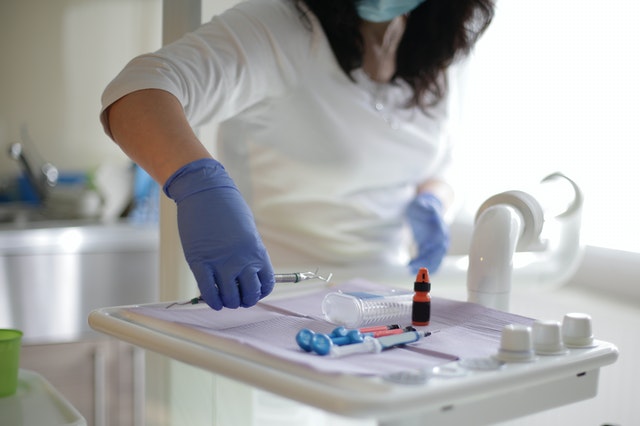The National Council Licensure Examination (NCLEX-RN test) evaluates whether you are qualified to work as an entry-level nurse. While nursing school examinations are information-based, the NCLEX-RN assesses the application and analysis of nursing knowledge. You will be tested on your ability to employ critical thinking abilities to make nursing decisions.
Understanding what does the NCLEX RN exam consist of is an important aspect of performing well on the NCLEX-RN. Here is a basic overview of what you should expect on the exam.
Let’s get started with our free NCLEX RN practice test to pass the real exam with a high score on your first try.
What Is On The NCLEX Exam?
What is on the NCLEX RN exam? The NCLEX-RN and PN examinations are computerized tests that consist mostly of multiple-choice questions, with some multiple-response, fill-in-the-blank, and drag-and-drop questions thrown in for good measure.
Count of Questions
The PN test has a minimum of 85 questions and a maximum of 205 questions in a regular year. The RN exam typically consists of 75 questions with a maximum of 265.
Computer Adaptive Testing
The NCLEX examinations are computer-adaptive tests (CATs), which means that the questions you receive are in direct reaction to the previous questions you answered. If you get a question wrong, the next one will be significantly easier. If you get an answer correct, the next question will be somewhat tougher. The computer’s estimation of your ability improves with each question you answer.
The NCLEX RN exam includes the following topics:
Safe and Effective Care Environment
- Management of Care – 17-23%
- Safety and Infection Control – 9-15%
Health Promotion and Maintenance – 6-12%
Psychosocial Integrity – 6-12%
Physiological Integrity
- Basic Care and Comfort – 6-12%
- Pharmacological and Parenteral Therapies – 12-18%
- Reduction of Risk Potential – 9-15%
- Physiological Adaptation – 11-17%
Safe and Effective Care Environment

The subcategories of Management of Care, Safety, and Infection Control make up the Safe and Effective Care Environment.
Management of Care
To safeguard the client and health care employees, the registered nurse delivers and coordinates nursing care that improves the care delivery setting.
Registered nurses must be competent to:
- Integrate advance directives into the client’s care plan.
- Assign and oversee the care of others (e.g., LPN/LVN, assistive workers, and other RNs).
- Organize your tasks to better manage your time.
- Take part in delivering cost-effective treatment.
- Start, assess, and update the care plan (e.g., care map, clinical pathway)
- Clients and staff should be educated on their rights and duties.
- Client rights and needs must be advocated for.
- When delivering client care, collaborate with professionals from various health care fields.
- Manage client and health care staff conflict
- Maintain the confidentiality and privacy of your clients.
- Report on allocated clients must be provided and received (e.g., standardized handoff communication)
- When recording care, use recognized acronyms and standard vocabulary.
- Carry out the processes required to securely admit, transfer, or discharge a client.
- Make client care a top priority.
- Recognize ethical quandaries and respond appropriately
- Practice in accordance with a code of ethics for registered nurses.
- Ascertain that the client understands and agrees to the treatment and procedures.
- Receive and/or transcribe instructions from health care providers.
- Use information resources to improve the care given to a client (e.g., evidenced-based research, information technology, policies, and procedures)
- Recognize your own and others’ limits and seek help.
- Client conditions must be reported if required by law (e.g., abuse/neglect, infectious illness, gunshot wound).
- Report harmful practices by healthcare workers and intervene as needed (e.g., substance abuse, improper care, staffing practices)
- Care must be provided within the legal area of practice.
- Participate in the process of performance/quality improvement and
- Recognize the importance of referrals and receive the appropriate orders
ALL of these subject areas will be examined above for the Management of Care section of this NCLEX-RN review, just as they will be for the other NCLEX-RN test content areas as outlined by the National Council of State Boards of Nursing.
Safety and Infection Control
The registered nurse safeguards the health and safety of patients and healthcare workers.
They must be capable of:
- Examine the client for allergies and act as necessary (e.g., food, latex, environmental allergies)
- Keep the customer safe from harm (e.g., falls, electrical hazards)
- When delivering care, ensure that the client is properly identified.
- Examine a treatment order for appropriateness and/or correctness.
- Implement emergency response strategies (for internal/external disasters, for example).
- When giving care, apply ergonomic concepts (e.g., assistive devices, proper lifting)
- Follow biohazardous material handling protocols.
- Educate the customer about home security problems.
- Recognize and document practice mistakes (e.g. incident report for medication error)
- Facilitate proper and safe equipment usage
- Take part in the institution’s security plan (e.g., newborn nursery security, bomb threats)
- Infection control concepts (e.g., hand hygiene, surgical asepsis, isolation, sterile procedure, universal/standard precautions) should be followed.
- Educate the customer and employees on infection control procedures.
- Follow the instructions for using restraints and/or safety equipment (e.g., least restrictive restraints, timed client monitoring)
Health Promotion and Maintenance
The registered nurse offers and leads nursing care for the client in this segment, which includes knowledge of predicted growth and development principles, prevention and/or early diagnosis of health concerns, and strategies to attain optimal health.
They must be capable of:
- Care and instruction are provided for the newborn less than one-month-old through the infant or toddler client to the age of two years.
- Preschool, school-age, and teenage clients aged 3 to 17 are cared for and educated.
- Adult clients from 18 to 64 years old should get care and education.
- Adult clients aged 65 to 85 years old should receive care and education.
- Prenatal care and education are available.
- Care for the client during labor, as well as post-partum care and education
- Client evaluation and instruction
- Clients’ health risks are assessed and taught based on family, demographic, and/or community factors.
- Determine the client’s readiness to learn, learning preferences, and learning hurdles.
- Community health education should be planned and/or participated in.
- Provide guidelines for health promotion and maintenance (e.g., physician visits, immunizations)
- Conduct specialized screening tests (e.g., vision, hearing, nutrition)
- Provide information on how to avoid and cure high-risk health behaviors (e.g., smoking cessation, safe sexual practices, drug education)
- Assess the client’s capacity to handle care at home and arrange care accordingly (e.g. equipment, community resources)
- Conduct a thorough health examination.
Psychosocial Integrity
You will be expected to demonstrate the knowledge and skills required to provide and direct nursing care that promotes and supports the emotional, mental, and social well-being of clients experiencing stressful events, as well as clients with acute or chronic mental illness, in the Psychosocial Integrity section of your exam.
The nurse should be able to do the following:
-
Evaluate the client for abuse or neglect and act as needed.
-
When caring for a client, use behavioral management approaches (e.g., positive reinforcement, setting limits)
-
Assess the client for drug/alcohol addiction, withdrawal, or toxicities and act as needed.
-
Assess the client’s ability to cope with life changes and offer assistance.
-
Consider the possibility of violence and take preparations (e.g., suicide, homicide, self-destructive behavior)
-
When planning and administering treatment, consider the client’s cultural habits and values.
-
Clients should be given end-of-life care and education.
-
Determine the plan of treatment by assessing family dynamics (e.g., structure, bonding, communication, boundaries, coping mechanisms)
-
Provide acute and chronic mental health care and education (e.g., anxiety, depression, dementia, eating disorders)
-
Plan treatments based on psychological, spiritual, and occupational elements impacting care.
-
Care for a client who has visual, auditory, or cognitive abnormalities (e.g., hallucinations)
-
Nonverbal indications of physical and/or psychological stresses
-
To give client assistance, use therapeutic communication approaches.
-
Create a therapeutic setting for people who are dealing with emotional or behavioral challenges.
There are several definitions of mental health. For example, mental health may be described as making effective changes and coping with everyday pressures in a way that is acceptable to society and beneficial for the client. Mental illness, on the other hand, maybe characterized as a person’s failure to adhere to social standards and acting in ways that are inappropriate in terms of the client’s conduct.
Some of the elements that influence the development of mental health include our inherited genetic make-up of one’s living circumstances, such as excellent physical health, economic stability, social support networks and friends, and nurturing during childhood, as well as those listed below.
Populations at Risk of Psychological Disorders Throughout Life

As a result of social isolation, grief/loss following the death of a spouse, friend, or another loved one, anxiety of deteriorating physical and mental skills, real physical and mental impairments, and lower-income, for example, older persons may be at risk for a lack of psychological integrity.
Sexual identity concerns, eating disorders, peer pressure, illegal drug use, and bullying are all common problems for adolescents and young people.
New parents frequently face stressors related to the transition from being a couple to being parents with great responsibilities, such as a potential loss of financial income, anxiety about the child’s well-being, concerns that they are insufficient parents, coping with the baby’s constant demands and needs, and some conflicts and ambivalence about accepting the pregnancy and the newborn.
Risk Factors Related to Gender
Women are at risk for mental illness as a result of domestic violence, hormonal changes after pregnancy and menopause, and internal, intrapersonal conflicts over the multiple and challenging roles they wish to or have to fulfill, such as full-time career, homemaker, single parent, and caregiver for elderly parents.
Economic and financial issues, loss of sexual functionality, and decreased muscular strength and stamina can all have a negative impact on men.
Secondary Risk Factors for Physical and Cognitive Illnesses and Disorders
Physically and intellectually challenged people are more likely to develop mental illnesses because they have a worse quality of life, a negative self-image, social isolation, a decreased sense of independence, societal stigma, and a lack of meaningful interactions.
Factors of Social Risk
Financial insecurity, poverty, low social standing, loss of self-esteem and self-worth, and other pressures affect the homeless, impoverished, and refugees.
The signs and symptoms of mental disease are not necessarily as apparent, unambiguous, and objective as those of a bodily ailment. Social disengagement, changes in personal habits such as grooming and cleanliness, atypical changes in mood, changes in cognitive processes, and other behaviors are all indicators and symptoms of mental illness.
The American Psychiatric Association’s (APA) Diagnostic and Statistical Manual of Mental Disorders (DSM) classifies mental disease into four primary groups. Many mental health issues are found in each of these four primary areas.
The four primary types of mental health problems recognized by the APA are as follows:
- Thought disorders are characterized by disorganized thoughts, feelings, and behaviors.
- Mood disorders, often known as mood affective disorders, have an impact on the client’s mood and affect. For example, the patient’s mood might be pleasant, ecstatic, solemn, sorrowful, depressed, or flat and emotionless.
- Behavioral disorders can appear as anger, aggressiveness, self-injury, damage to others, and disobedience.
- Mixed disorders must identify traits, signs, and symptoms of more than one of the APA categories of mental health disorders listed above.
Mental health diseases can also be classified and characterized as follows:
- Sexual dysfunctions
- Disorders of gender identity
- Delirium, dementia, and Alzheimer’s disease are examples of cognitive diseases.
- Disorders with poor impulse control
- Alcohol and illicit drug misuse, reliance, and addiction are examples of substance abuse disorders.
- Anxiety illnesses such as obsessive-compulsive disorder, phobias, and panic attacks
- Sleep problems
- Anorexia nervosa and other eating disorders
- Depression and bipolar disorder are examples of mood disorders.
- Schizophrenia can be classified as paranoid or catatonic.
- Personality problems such as dependent and antisocial personalities
Physiological Integrity
You will be asked to show the knowledge and abilities required to enhance physical health and wellbeing by providing care and comfort, lowering client risk potential, and managing health changes in the Physiological Integrity section of your test.
Basic Care and Comfort, Pharmacological Therapies, Risk Potential Reduction, and Physiological Adaptation are the four subsections of Physiological Integrity.
Basic Care and Comfort
The nurse will be needed to demonstrate their ability to give comfort and aid in the execution of activities of daily living in the Basic Care and Comfort questions.
The nurse must be capable of:
-
Assist the client in compensating for a physical or sensory deficit (e.g., assistive devices, positioning, compensatory techniques)
-
Evaluate and manage a customer with a change in elimination (e.g., bowel, urinary)
-
Irrigate the lawn (e.g., of the bladder, ear, eye)
-
Conduct a skin examination and put measures in place to preserve skin integrity and avoid skin breakdown (e.g., turning, repositioning, pressure-relieving support surfaces)
-
Orthopedic devices can be used, maintained, or removed (e.g., traction, splints, braces, casts)
-
Implement and maintain venous return devices (e.g., anti-embolic stockings, sequential compression devices)
-
Implement circulation-boosting methods (e.g., active or passive range of motion, positioning, and mobilization)
-
Determine the client’s pain management requirements.
-
Non-pharmacological comfort measures should be provided.
-
Control the client’s dietary consumption (e.g., adjust diet, monitor height, and weight)
-
Provide sustenance to the client via continuous or intermittent tube feedings.
-
Assess client intake and output and intervene as necessary.
-
Assess and intervene in client performance of daily living activities
-
Provide post-mortem care
-
Evaluate the client’s need for sleep/rest and act as necessary.
Pharmacological and Parenteral Therapies
The registered nurse is responsible for drug administration and parenteral therapy.
Registered nurses must be competent to do the following:
- Administer blood products and assess client reaction
- Tunneled, implanted, and central lines are examples of venous access devices.
- Carry out the calculations required for drug administration.
- Assess the client’s response to medicine (e.g., therapeutic effects, side effects, adverse reactions)
- Inform the client about drugs.
- Prepare and dispense drugs while exercising medication administration powers.
- Before administering medicine, review all important facts (e.g., contraindications, lab results, allergies, potential interactions)
- Take part in the medication reconciliation procedure.
- Medication dose should be titrated depending on evaluation and required criteria (e.g., giving insulin according to blood glucose levels, titrating medication to maintain specific blood pressure)
- Examine the appropriateness and correctness of the prescription order for the client. Monitor intravenous infusion and keep the site clean (e.g., central, PICC, epidural, and venous access devices)
- Administer pharmaceutical pain relief methods.
- Administer restricted drugs in accordance with regulatory requirements (e.g., witness, waste)
- Administer parenteral nourishment and assess the client’s reaction (e.g., TPN)
Some of the often used words and phrases associated with pharmacological and parenteral therapies that you should be aware of and informed about are briefly given below:
- Pharmacokinetics is the study of drug absorption, distribution, metabolism, and excretion.
- Pharmacodynamics: Pharmacodynamics is the study of how drugs work in the body. Pharmacodynamic concepts include drug concentrations, receptor and binding activities, and antagonistic and agonist effects.
- Drug absorption is the pharmacokinetic process through which medicine travels through the body and into the bloodstream. Intravenous drugs are not absorbed since they are administered straight into the bloodstream. Oral medicine absorption rates vary depending on the acidity of the stomach juices, the presence of food, and other variables.
- Drug distribution: The flow of medicine through the circulation to its destination is the second step of the pharmacokinetic process. Fat-soluble drugs are drawn to fatty tissue targets.
- Drug metabolism or biotransformation: The third step of the pharmacokinetic process is drug metabolism, also known as biotransformation. The detoxification and breakdown of pharmaceuticals in the liver are referred to as drug metabolism.
- Excretion: The removal of active and inactive drug metabolites from the body is characterized as the ultimate step of pharmacokinetics. The kidney and urine tract eliminates the greatest majority of drugs, however, the respiratory and gastrointestinal tracts may also excrete some.
- Drug indications: Medication indications are diseases, disorders, illnesses, and situations that are suitable applications for a certain medication. For example, the indications for the use of phenobarbital include seizure management, seizure prevention, anxiety reduction, and withdrawal from a barbiturate. The Food and Drug Administration in the United States establishes drug indications. When a medicine is used for purposes other than those listed on the label, this is referred to as an “off label use.”
- Medication contraindications: Almost all drugs are not indicated for, and so are contraindicated for, specific customers due to one or more illnesses. Pregnant women, for example, should avoid drugs classed as Categories C, D, and X. Many medications are not recommended during pregnancy, nursing, or if the client has a history of renal or hepatic impairment, for example.
- Medication administration with caution: Many medications, like contraindications, have published precautions that indicate the cautious use of medication based on the client’s status; although the cautious use of a medication is often done, it is done with the provision that the client will be closely monitored and assessed for any adverse effects.
- Drug therapeutic effects: A therapeutic effect is the desired effect of a certain medication. Anti-anxiety drugs, for example, have the therapeutic and intended impact of lowering the client’s anxiety level, whilst anti-hypertensive meds have the therapeutic and desirable effect of lowering the client’s blood pressure.
- Medication side effects: A medicine side effect is any impact(s) other than the therapeutic and intended effect(s) of a medication. Some side effects are harmful to a client, while others are innocuous, and still, others may be a positive side effect that is therapeutic for the client. These adverse effects can include damage to the 8th cranial nerve, slight mouth dryness, and tiredness after taking an antihistamine such as diphenhydramine, which is used to induce sleep rather than for antihistamine purposes by many individuals, particularly the elderly.
- Idiosyncratic side effects of medicine: Idiosyncratic side effects of medication are those that are rare, odd, or unexpected. These side effects might include a client becoming hyperactive after taking a sedative medicine. These impacts are often individual rather than shared by a group or community of customers afflicted by a certain risk factor for the disorder, for example.
- Medicines cumulative effects: Medication cumulative effects are the effects that occur as a result of the accumulation of medication. Cumulative effects of pharmaceuticals can arise as a result of numerous altered pharmacokinetic processes, including impaired drug biotransformation and excretion, as is common in senior customers due to some of the typical changes in the aging process. The cumulative effects of a medicine can sometimes result in a life-threatening overdose of the medication; hence, caution must be used when a client is at risk for the accumulation of a medication and its cumulative effects.
- Pharmaceutical adverse effects: Medication adverse effects are significantly more dangerous and unpleasant than medication side effects. An anaphylactic reaction to an antibiotic, for example, is a side effect of that medicine. Unless there are unique conditions, drugs that cause undesirable effects are promptly ceased.
- Drug interactions occur when pharmaceuticals and meals interact, drugs and herbs or supplements interact, and drugs interact with other drugs. Some medication interactions are synergistic and potentiating, while others may be inhibitory.
- Medication potentiating effects: A potentiating effect is the synergistic, additive impact that happens when pharmaceuticals and foods interact, drugs and herbs or supplements interact, and drugs and other drugs interact. The former two interactions will raise the medication’s potency, whereas the latter will be enhanced by one or more of the interacting drugs.
- Medication inhibiting effects: A medication inhibiting effect is a reduced impact that happens when medications and foods interact, drugs and herbs or supplements interact, and drugs and other drugs interact. The former two interactions will lessen the medication’s effects, while the latter will have a reduced and inhibitory impact on one or more of the interacting drugs.
- Overdosage of a drug: Overdosage of medication happens when the dose supplied exceeds the client’s ability to metabolize and/or excrete the medication.
- A drug allergy is caused by an antigen-antibody immunologic reaction to a medicine. All customers must be tested for medication sensitivities and allergies.
- Drug tolerance happens when a client has been taking certain treatment, such as an opioid drug, for an extended length of time and, as a result, the client requires higher dosages of the prescription to generate the therapeutic effect.
- A drug’s chemical name is: The chemical name of a drug is the substance’s chemical makeup.
- A drug’s trade or brand name: A drug’s trade or brand name is the drug’s manufacturer’s name. Generic medications are less costly than brand-name pharmaceuticals.
- The generic name of a drug: A drug’s generic name is the name assigned to it by the United States Adopted Names Council. This name has not changed throughout time. A generic pharmaceutical can have several trade names, but a trading name is the sole property of the drug maker, thus there can only be one. Metoprolol, for example, has various commercial names, including Metoprolol Succinate and Lopressor, both of which are capitalized, unlike generic names.
Reduction of Risk Potential
The Risk Reduction Potential questions may assess the nurse’s competence to lessen the probability of clients developing difficulties or health problems as a result of current conditions, treatments, or procedures.
The nurse must be able to do the following:
-
Examine and respond to changes in the client’s vital signs.
-
Carry out diagnostic tests (e.g., electrocardiogram, oxygen saturation, glucose monitoring)
-
Keep an eye on the outcomes of diagnostic tests and intervene as required.
-
Collect blood samples either peripherally or through the central line.
-
Obtain non-blood specimens for diagnostic testing (e.g., wound, stool, urine)
-
Inserting, retaining, and removing a gastric tube
-
Inserting, retaining, and removing a urinary catheter
-
A peripheral intravenous line is inserted, maintained, and removed.
-
Precautions should be taken to avoid damage and/or problems connected with surgery or diagnosis.
-
Examine how people react to procedures and treatments.
-
Recognize patterns and changes in the client’s condition and act as necessary.
-
Conduct a focused assessment
-
Inform the customer about the treatments and processes.
-
Give prior and postoperative instructions.
-
Give preoperative care.
-
Give intraoperative care.
-
Manage the client during and after a mild sedation treatment.
Physiological Adaptation
The Physiological Adaptation questions will assess the nurse’s competence to manage and care for clients who have acute, chronic, or life-threatening physical health issues.
The nurse should be able to do the following:
- Aid in invasive procedures (e.g., central line, thoracentesis, bronchoscopy)
- Phototherapy should be implemented and monitored.
- Maintain a comfortable temperature for the customer (e.g., using a cooling and/or warming blanket).
- Clients on a ventilator must be monitored and cared for.
- Drainage devices and equipment must be monitored and maintained (e.g., surgical wound drains, chest tube suction, negative pressure wound therapy)
- Perform and supervise the treatment of peritoneal dialysis patients.
- Suction is used (e.g. oral, nasopharyngeal, endotracheal, tracheal)
- Provide wound care or replace dressings
- Offer ostomy care and education (e.g. tracheal, enteral)
- Provide respiratory hygiene (e.g., chest physiotherapy, incentive spirometry)
- Give postoperative treatment.
- Take care of a client who has a fluid and electrolyte imbalance.
- Maintain and monitor arterial lines
- Use a pacing device to manage a client’s care (e.g., pacemaker)
- Manage a client’s care via telemetry.
- Manage the care of a hemodialysis patient.
- Manage a client’s care when there is a change in hemodynamics, tissue perfusion, or hemostasis (e.g., cerebral, cardiac, peripheral)
- Inform the client about an acute or chronic ailment.
- Take care of a person who has poor ventilation/oxygenation.
- Assess the efficacy of a therapy plan for a client with an acute or chronic condition.
- Carry out emergency care protocols (e.g., cardio-pulmonary resuscitation, respiratory support, automated external defibrillator)
- Determine the pathophysiology of acute or chronic disease (e.g., signs and symptoms)
- Recognize problems’ indications and symptoms and respond properly while providing client care
How Do I Get Ready For The NCLEX-RN?
To assist you to maximize your time and efforts, test plans present you with several lists and categories of what you should know for the test. For example, if you want to learn more about lab values, the laboratory value section will teach you the main ideas you need to know.
Among these notions are:
- Obtaining blood samples through a central line
- Patient information on laboratory testing and procedures
- When to tell a healthcare practitioner about lab results
The NCLEX was somewhat revised in 2016. For example, the wording and amount of questions per category have not changed from the prior edition. The most significant modifications, however, have been made to the section on Management of Care, which now includes organ donation and advanced directives/self-determination/life.
How Will You Find Out Whether You Passed or Failed the NCLEX?

As previously stated, you will receive your official results up to 6 weeks after taking the test. According to the NCBSN, the CAT testing format employs three different scenarios to decide whether or not an applicant has completed the test:
95% Confidence Interval Rule
This is the most commonly applied rule. Essentially, after the computer has established with 95 percent certainty whether you passed or failed the test, it will stop asking you questions.
Maximum-length Exam Rule
This is when the computer keeps asking you questions until you’ve exhausted all of your options. It will do this when you are close to passing the exam. It will then look at your final ability estimation to see if you passed.
Run-Out-Of-Time-Rule (R.O.O.T.)
If you run out of time before completing all of the objects, one of two things can happen. If you answered the required amount of questions, the computer will assign you a score based on your final ability estimation. You will fail the exam if you do not answer the required amount of questions.
FAQs – What Does The NCLEX RN Exam Consist of?
How much does the NCLEX examination cost?
In 2022, the NCLEX-RN will cost $200 for applicants in the United States.
How long does the NCLEX RN take?
On the NCLEX, the minimum number of questions is 75 and the maximum number of questions is 145. The test can be completed in a maximum of 5 hours, including all breaks.
What happens if you fail the NCLEX?
If you do not pass the exam, you will be given a Candidate Performance Report that breaks down the eight sections of the exam and reveals where you were above, near, and below the passing criteria. This might help you pick which areas to focus on if you decide to retake the exam.
While failing the NCLEX might be disheartening, there are several possibilities to retake the exam. Though your state may have a limit, the NCSBN permits applicants to take the exam up to eight times per year, with at least 45 days in between.
What happens after you have passed the NCLEX?
Congratulations on passing the NCLEX! Your final step toward working in the nursing sector is to get state licensure. Each state’s process varies significantly, so check with your state board to confirm any additional processes.
If you become an RN, you may want to pursue concentrating in one field of nursing. Many nursing specializations provide certificates, and obtaining one might help you grow in your profession.
Conclusion
The NCLEX-RN is a mandatory examination for nursing students in order to get licensure as a registered nurse. Our nursing programs at Joyce focus on RN licensure, which is why students may take the NCLEX after only 5 semesters (about 18 months). The ability to enter the job as a registered nurse as soon as you pass the NCLEX is one perk of taking the exam early. That means you may start working and earning money while finishing your degree. Hope that our article about what does the NCLEX RN exam consist of will help you in preparing for your future exam. Good luck to you guys.

PCCN vs CCRN: Which Certification Should I Take?
In this discussion, we will examine the fundamental distinctions between PCCN vs CCRN certifications, allowing you to make an informed and right decision about which certification is best for your nursing career progression.
June 20, 2023

Is PCCN Worth It? A Comprehensive 2025 Study Guide
In this article, we will provide all the enrollment criteria, how to apply, whether is PCCN worth it for you to obtain, and how to get a high mark.
June 20, 2023

PCCN Requirements - How to Become a Progressive Care Certified Nurse?
To become a progressive care nurse, you must first obtain the PCCN certification. This post will help you understand PCCN certification, PCCN requirements, and efficient approaches to obtaining this certification.
June 20, 2023
